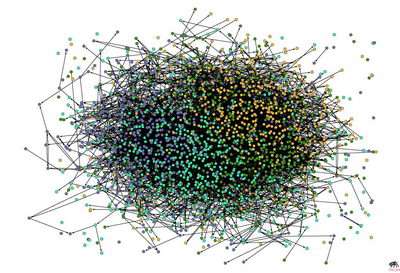March 10, 2006 feature
The Physics of Friendship

By comparing people to mobile particles randomly bouncing off each other, scientists have developed a new model for social networks. The model fits with empirical data to naturally reproduce the community structure, clustering and evolution of general acquaintances and even sexual contacts.
Applying a mathematical model to the social dynamics of people presents difficulties not involved with more physical – and perhaps more rational – applications. The many factors that influence an individual’s fate to meet an acquaintance and decide to become a friend are impossible to capture, but physicists have used techniques from physical systems to model social networks with near precision.
By modeling people’s interactions based on how particles bounce off each other in an enclosed area, physicists Marta Gonzalez, Pedro Lind and Hans Herrmann found that the characteristics of social networks emerge “in a very natural way.” In a study recently published in Physical Review Letters, the scientists compared their model to empirical data taken from a survey of more than 90,000 U.S. students regarding friendships, and found similarities indicating that this model may serve as a novel approach for understanding social networks.
“The idea behind our model, though simple, is different from the usual paradigmatic approaches,” Gonzalez told PhysOrg.com. “We consider a system of mobile agents (students), which at the beginning have no acquaintances; by moving in a continuous space they collide with each other, forming their friendships.”
After a collision, a particle moves in a different direction with an updated velocity, just as how an individual’s chance of meeting a new person depends on their most recent acquaintances.
At a critical point, the system reaches a quasi-stationary state, for the first time allowing the scientists to reproduce several features of social networks in a single model and in a natural way. Specifically, this technique accurately describes social clustering, the way friendships evolve over time, the shortest path length in a large group, and some features related to group structure.
“With this new framework, we show that specific velocity and collision rules are able to reproduce the statistical and structural features of empirical social networks,” said Gonzalez. ”Therefore, this model seems to have the novelty of bringing together all the previous developments for collision theory with the empirical results of socio-dynamics.”
The scientists were also able to apply this model to describe specific types of contacts to produce a distribution that again closely resembles real-life acquaintances. For example, to separate sexual contacts from all social contacts, the scientists assigned to the sexual contacts an intrinsic property that could then be used to model these distinct networks. In this case, the model reproduced the real sexual contact network found in a tracing study of HIV tests.
Although this particle motion does not literally model human motion, it represents connections among people – and it’s these links that contain the most significance for social networking theories. For example, links can represent the flow of information traveling through a community. By knowing the shortest path, communicators can optimize the information flow and improve productivity in a business. With the ability to determine hot hubs or holes in a community, business managers can identify leaders or points that require an organizational change.
As Gonzalez sees it, statistical physics and human behavioral studies have a history of inspiring each other, which makes physicists’ desire to understand social networks a natural interest.
“As Philip Ball [Nature Editor] remarks,” said Gonzalez, “‘by seeking to uncover the rules of collective human activities, today's statistical physicists are aiming to return to their roots: Social statistics also guided Maxwell and Boltzmann towards the utilization of probability distributions in the development of the kinetic theory of gases – the foundation of statistical mechanics’ (Physica A 314 (2002) 1-4)."
Citation: Gonzalez, Marta C., Lind, Pedro G. and Herrmann, Hans J. System of Mobile Agents to Model Social Networks. Physical Review Letters. 96, 088702 (2006).
By Lisa Zyga, Copyright 2006 PhysOrg.com


















